ingredients receivings

Ingredient receiving can be either created from the screen or manually entered in the Ingredient
Receiving screen. Receiving transactions record the ingredient in inventory
at the received cost as defined in the purchase order. Journal transactions
are recorded at receiving to record the charge to inventory/expense and
the offset to accounts payable accrual.
Prior to creating a Planned Ingredient Receiving, the following items
must be created:
The following procedures are outlined related to creating an Ingredient
Receiving:
Create
an Ingredient Receiving
- In FMTS>FMIM>Transactions>Ingredients,
select Receivings.
- In the Ingredients Receivings main index,
select
 to create a new record.
to create a new record.
Ingredient Receiving Header
The Header section contains three sections:

General
Select the Feed
Mill No that identifies the feed mill that is receiving the
ingredients.
- Select the Vendor
No that indicates the vendor that is supplying the ingredients.
- Invoice Vendor
No will default based on the selected Vendor No. This field
is only modified if the non-receiving vendor logic is used. When the
purchase invoice is processed, the available receiving transactions
will be filtered based on the selected Vendor No and Invoice Vendor
No. Click to review the non-receiving vendor
logic.
- In the Trans
Date Time field, enter the date and time that the ingredients
were received.
- Enter the Ship
Date to indicate the date that the ingredient was shipped
from the vendor.
- Ref No
is an automatically-generated reference number that uniquely identifies
the receiving transaction.
- Supplier Ref
No is an optional field that is used to transfer the supplier
reference from the purchase order.
- Location ID
indicates the location from which the vendor shipped the ingredients.
Location ID is set up in:
- Transport Vendor
No displays the vendor that hauled the goods if the purchase
order excluded or delayed freight.
- Driver No
is an optional field to identify the internal driver delivering the
ingredients. The driver codes must be set up prior in: .
- External Driver
is an optional text field to identify the external driver delivering
the ingredients.
- Vehicle No
is an optional field to identify the internal vehicle that is delivering
the load. Vehicle codes must be set up prior in: .
- External Vehicle
is an optional text field to identify the external vehicle that is
delivering the load.
- Trailer No
is an optional field to identify the internal trailer that is delivering
the load. Trailers must be set up prior in: .
- Selecting the Void
Flag will delete the transaction and all corresponding journal
transactions.
- In the Comments
field, enter any additional details related to the receiving transaction.
- In the Reject
Comments field, indicate the reason that the load was rejected,
if applicable.
Amounts
and Settings
- Enter the No
of Receivings to indicate the number of receipts for the receiving
transaction. A default of ‘0’ indicates a single receiving transaction.
- Select the Scale
No that is reading the weights. This must be set up prior to
creating receiving transaction in: .
- From Scale
Operator No, select the scale operator number.
Scale operators must be set up prior to creating the receiving
transaction in: .
- In the Gross
field, enter the gross weight of the vehicle. This field can be manually
read or interfaced from a scale.
- In the Tare
field, enter the tare weight of the vehicle. This field can be manually
entered or interfaced from a scale.
- Net is
the difference between gross and tare. This field can be manually
entered or if weights are entered, it is calculated automatically.
- Assay Complete
is not selected by default, and is used in conjunction with the Planned
Receiving screen. When testing of the assays is required, the
'Assay Complete' box is selected. This will turn the calendar
option to blue to let the user know the status that the truck is in
the yard awaiting assay testing.
- Selecting the Assay
Override Flag will allow the user to receive the ingredient
even if the assays are outside of the tolerance levels.
- Gross Wt Date
Time displays the date and time that the gross weight was recorded
at the scale.
- Gross Wt Scale
Ref No displays the reference number for the gross weight scale
reading.
- Tare Wt Date
Time displays the date and time that the tare weight was recorded
at the scale.
- Tare Wt Scale
Ref No displays the reference number for the tare weight scale
reading.
- Tare Auto Manual
indicates the tare setting of Auto or Manual.
- Gross Zero Weight
Button is used if a zero weight
is required.
- Gross Zero Weight
Date Time indicates date and time that zero weight was recorded.
- Gross Zero Weight
Scale Ref is a reference number generated from the scale for
the zero weight.
- Tare Zero Weight
Button is used if a zero weight is required.
- Tare Zero Wt
Date Time indicates date and time that zero weight was recorded.
- Tare Zero Wt
Scale Ref is a reference number generated from the scale for
the zero weight.
Derived
The information in the Derived fields automatically generates from the
first two grids - General and Amounts and Settings. The fields are read-only
and cannot be modified.
- Feed Mill Name
is derived from the selected feed mill.
- Vendor Name
represents the vendor that is shipping the ingredients.
- Location Name
is assigned to the vendor and indicates the name of the location that
the ingredient is being shipped from.
- Transport Vendor
Name is the derived name of the haulage vendor selected for
the transaction.
- Driver Name
represents the internal driver that is delivering the ingredients.
- Vehicle Name
defines the internal vehicle that is delivering the ingredients.
- Trailer Name
indicates the trailer that is transporting the ingredients.
- Scale Operator
Name represents the name of the individual that was responsible
for entering the scale data.
- Purchase Trans
Code for receiving transactions will always be defined as Purchase.
- Status
represents where the transaction is in the receiving process. The
status drives the color coding in the
screen.
Total Amount
represents the total amount of the transaction including product,
add-ons, freight and taxes.
Receiving
Line Details
The line details relate to the product that is being received from the
vendor. In the child grid for the line item are the details related to
add-ons and assays. These amounts will default as defined from the purchase
order and cannot be modified at receiving. If there is freight assigned
to the product, there will be two lines appear in the lines details for
each product received. The first line will be related to the product details
and amount with the second line referencing the freight amounts.
- Click on the Details
grid.
- Select
 to create a new PO Inventory screen.
to create a new PO Inventory screen.
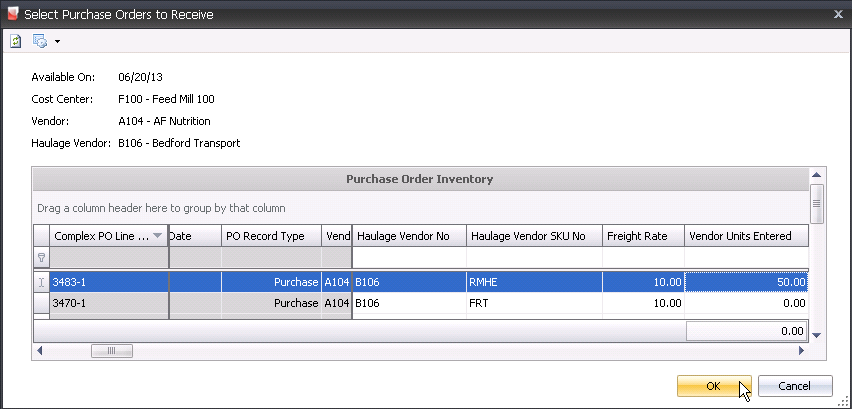
- Select the appropriate PO line.
- In the Vendor
Unit Entered field, enter the number of inventory units for
the receiving transaction. There is a registry switch option - Product Type>Receiving Units Mode
- that determines if the products are received by vendor units
or inventory units.
- If the purchase order has the freight type set
to Delayed,
Haulage Vendor No , Haulage Vendor SKU No and Freight Rate can be modified if
required in the selection grid.
- Click the OK button to create the line details.
- The Details tab contains the base information
relating to the products being received from the vendor. There are
several fields on the receiving transaction which will be displayed
in multiple sections for this part of the document.

- Complex Po No
indicates the purchase order that is being received. Purchase orders
must be in 'Posted' status. Purchase orders will be filtered based
on the cost center and vendor selected in the header.
- In the Product
No field, enter the product number that is being received on
the purchase order.
- Product Name
defaults from product No and displays the name of the product being
purchased.
- Lot No
is an optional field to record the lot number for the ingredient being
received. The lot number will follow the ingredient through to the
production process. Costs will remain with the defined lot.
- Silo No
is an optional field to record the silo location from which the product
is being received. Costs will remain with the defined silo.
- Silo Name
defaults from Silo Name and displays a description of the selected
silo.
- Pay Basis
defaults from the purchase order and indicates if the payment to the
vendor is being determined based on the received weight, shipped weight
or net payment weight.
- Received Weight indicates
the weight that is being received. This amount will default from the
net weight in the contract header. Depending on a setup switch that
determines whether the receiving transactions are recorded based on
inventory units or vendor units, this field may be automatically calculated.
- Received Vendor
Units indicates the number of vendor units that are being
received. For example, the received weight is in pounds, but the product
was purchased from the vendor in tons. Depending on a setup switch
that determines whether the receiving transactions are recorded based
on inventory units or vendor units, this field may be automatically
calculated.
- Shipped Weight
is an optional field to enter the shipped weight if the vendor is
being paid based on shipped weight. Depending on a setup switch that
determines whether the receiving transactions are recorded based on
inventory units or vendor units, this field may be automatically calculated.
- Shipped Vendor
Units is an optional field to enter the shipped vendor units
if the vendor is being paid based on shipped weight. Depending on
a setup switch that determines whether the receiving transactions
are recorded based on inventory units or vendor units, this field
may be automatically calculated.
- Net Payment Weight
is a calculated field that is used when the assay result modifies
the weight that the vendor will be paid for the product. In the assay
definition in or Ingredient
Versions, the Scan Comparison value is set to Weight Adjustment.
- Net Payment Units
is a calculated field the will be calculated then Net Payment Weight
option is used. The units will be based on the weight adjusted and
in inventory units for each vendor unit.
- Unit Description
is derived from Vendor Sku and displays the unit of measure from which
the product was purchased from the vendor.
- Units Per is
derived from Vendor Sku and indicates the number of units in
each vendor unit.
- The Unit Price
defaults from the PO with no option to modify at receiving.
- Amount
is a calculated field for the Received/Shipped/Net Payment Vendor
Units x Unit Price.
- Total Add-ons
is a calculated total amount of premium add-ons that will be added
to the vendor payment based on the amounts defined in the purchase
order. Details are located in child grid.
- Total Discounts
is a calculated total amount of discount add-ons that will be deducted
from the vendor payment based on the amounts defined in the purchase
order. Details are located in child grid.

- Total Taxes
is a calculated amount based on the taxable product and/or add-ons
as defined in the purchase order. Details are located in the child
grid.
- Total Assay Penalty
is a calculated amount that will be deducted from the vendor payment
based on the configuration of the assays. Details are located in the
child grid.
- Total Assay Bonus
is a calculated amount that will be added to the vendor payment based
on the configuration of the assays. Details are located in the child
grid.
- Total Amount
is a calculated total amount of the receiving transaction based on
the amounts that are defined in the purchase order.
- Bill of Lading
is a location to enter the bill of lading reference for the receiving
line.
- Currency No
is derived from the purchased order.
- Currency Name
is derived from the Currency No.
- Prepaid Final
Receiving check box will be checked if the receiving is the
final receiving. This option is only required if the prepaid purchase
order will have multiple receipts. By selecting this option, the journal
transaction will clear out the remaining accrual and book any incurred
differences to the purchase price variance account.
- Expiration Date
can be used to enter the expiration date of the product.
- Container Count
can be used to enter the number of containers required.
- Adjusted Net
Additional
Line Details
Within the Complex Po No field, there is a child grid containing additional
details relating to the ingredients receiving.
Premium and discount add-ons default from the purchase order. Amounts
will be calculated based on the amount received.

- Product No
displays the code of the selected add-on.
Product Name displays a description
of the add-on.
Transaction Basis is a read-only
field that defaults from the selected add-on and determines how the
add-on is calculated on orders. Options are: Per Unit, Percentage,
Flat Rate, or Free Percentage.
Payment
TypeTransaction:
Processed with the sales invoice.
Rebate: Processed at a date later than the invoice..
Internal: An internal transaction is a transaction that is not invoiced
to an external source (Example: There is an internal haulage
department that gets a credit for hauling products).
is a read-only field that derives from the purchase order and determines
when the add-on payment is made.
Payee Type is an optional field
that indicates the source type for the premium or discount add-on.
Transaction
Entity ID is a required field if a different Payee Type is
selected. If Payee Type is set, the selected vendor or cost
center name will appear in this field.
Pay Calculation
Type defaults from the vendor sku and determines the base amount
of the add-on calculation.
Product
Amount - the add-on is calculated based on only the product
amount and does not include any other add-on in the calculation
of the amount.
Net
Amount - the add-ons is calculated based on the net amount
of the transaction based on the product amount including other
add-on amounts, but excluding taxes.
- Vendor Calculation
Type determines if the payment is calculated based on
the base add-on logic using Transaction basis or if the add-on amount
is only deducted from the vendor payment.
Normal
- the add-on is calculated based on the rules established
by Transaction Basis and the Payment Type defined in the vendor
SKU and sales SKU.
Deduction
Only - the add-on is calculated based on the rules
established by Transaction Basis, however the add-on is only
deducted from the vendor payment.
Taxable identifies if the item is
taxable or non-taxable when the add-on is purchased. The flag will
be selected if the item is taxable.
Currency No defaults based on the
currency assigned to the purchase order as defined, with no option
to modify.
Currency Name displays a description
of the currency type.
Amount displays the total cost of
the add-on.
Product Assurance relates to the assays that are assigned in the purchase
order. There is the option to define penalty and bonus calculations so
that the vendors are penalized or rewarded based on the quality of the
product being received.

- Assay No
identifies the assay.
- Assay Name
displays a description of the assay.
- Result displays the assay rate.
- Rate Type indicates the source type
for the rate.
- Rate displays the assay rate.
- Rate Adjustment is used to enter
any adjustment for the rate.
- Assay Amount displays the total
amount of the assay.
- Min Value displays the minimum value
of the assay.
- Max Value displays the maximum value
of the assay.
Tax codes as defined on the purchase order will default to the receiving
transaction. The amount will be calculated based on the rate that is in
effect on the receiving date. There are two types of taxes.
- Accrual Taxes:
Will record the tax accrual and record the journal transaction at
time of receipt.
- Invoice Taxes:
Will calculate the tax at time of receipt, however the journal transaction
is not created until the purchase invoice is processed. Invoice taxes
are generally used for federal taxes that are reimbursed to the company
by the government and cannot be actually recorded until the vendor
invoice is received.

- Tax No
identifies the tax code.
- Tax Name
displays a description of the tax code.
- Amount
displays the total amount of taxes.
Post a Receiving Transaction
Once the receiving transaction has been created and saved, the transaction
needs to be posted. The posting process completes the following:
- Records the product to inventory
- Locks the receiving transaction record
- Creates the journal transaction to record
the accruals and amounts to the required accounts.
The UnPost option unlocks the receiving transaction and reverses the
journal transactions created at post. Once the receiving transaction has
been posted, the can be processed to
pay the vendor.
- In the Ingredient Receiving Transaction index,
select the required transfer transaction and right-click to select
'Post'. Alternatively, click the green check mark
 in the top menu bar and select 'Post'.
in the top menu bar and select 'Post'.
- To un-post a receiving, select the required receiving
transaction and right-click to select 'UnPost' or select Options>UnPost.
This process will set the transaction status to Reversed which allows
the transaction to be edited. The unposting process will also reverse
the journal transaction created in the post process.
Journal
Transaction
The posting process creates the journal transaction. The journal will
record the product to inventory and create the accounts payable accrual.
| DEBIT |
Ingredient
Inventory |
| CREDIT |
Accounts Payable Accrual |

Right-Click
Options
While in the In the FMIM Ingredients Receiving index screen, more transaction
options are available by right-clicking on any line item. These options
are also available on the menu:
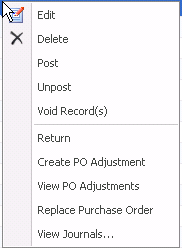
- Edit allows
changes to be made to the record before it is posted.
- Delete
removes the record completely from the system. Records
must be in 'Unposted' status first.
- Post locks
the record and the record becomes-read only.
- Unpost
unlocks the record so the record can be edited.
- Void Records
leaves the record in the system in 'voided' status, and also voids
the journal transaction so it is not included in the data. This options
is used when an audit trail is needed..
- Return
is used when the feed/ingredient was returned to the vendor.
- Create PO Adjustment
allows the adjustment of the outstanding amount on the purchase
order. This applies to debit or credit adjustments.
- View PO Adjustments
shows a summary of the adjustments that have been made to the PO for
the ingredient that is being received.
- Replace Purchase
Order is used if the purchase order has been
received to the wrong PO.
- Print Ingredient
Ticket prints the default system ingredient receiving ticket
as long as the report is mapped in Admin>System>Screen
Report Mappings. *Note:
This is not used in V 7.26 and upé
- Print Ingredient
Vehicle Auth. Doc prints the default system vehicle authorization
report if the report is mapped in Admin>System>Screen
Report Mappings. *Note:
This is not used in V 7.26 and upé
Create
an Ingredient Return
An Ingredient Return Transaction is created when the product is returned
to the vendor and the vendor will receive credit for the product that
is returned. The ingredient is returned from the original receiving transaction,
therefore all of the pricing details will default based on the purchase
order assigned to the receiving transaction. Once the ingredient return
is posted, the credit memo payable can be processed using Purchase
Invoices>Vendor Return.
- In the FMIM Ingredients Receiving index, right-click
on the required receiving record and select 'Return'.
- Enter the date of the return in the date prompt.
- The Purchase Return dialogue will appear.
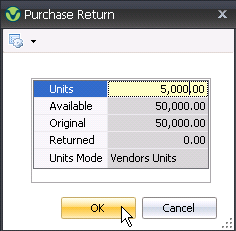
- Enter the number of Units
that are being returned to the vendor. The maximum total amount returned
cannot exceed the original receiving transaction.
- Available
auto-populates, and is the amount of receiving units that are available
to be returned.
- Original
auto-populates, and is the number of original purchased units.
- Returned
auto populates with the units of previous returns for this record.
- The Units Mode
indicates whether the units are entered based on inventory units or
vendor units. This is determined by the Received Units Mode established
in the registry by product type.
- Click `OK` to create the vendor return.
- The FMIM Ingredient Receiving screen will appear
with the returned weight and the pricing details, based on the purchase
order, defaulting into the screen.
- The Ref No will be set to the same reference number
as the original receiving transaction.
- The Purchase Trans Code will be set to Return
to indicate that the transaction is a return transaction.
- Save and close the transaction.
- Post record.
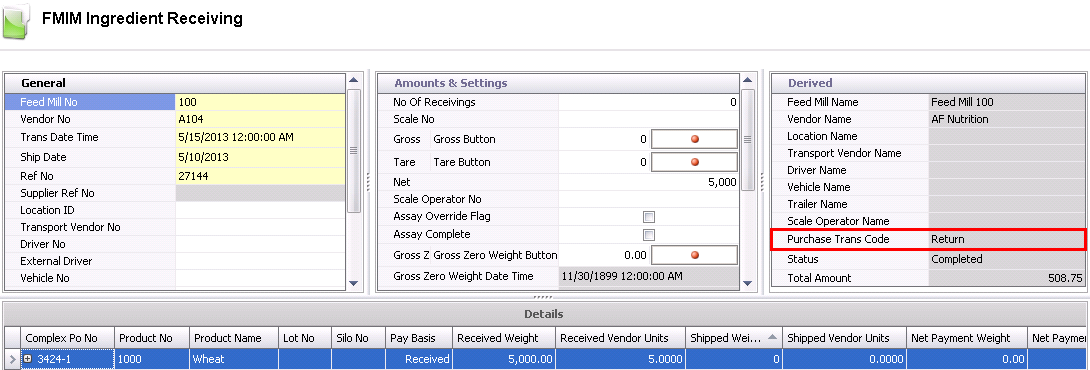
- Once the vendor return transaction has been posted,
the credit to the vendor can be completed using the Purchase
Invoices>Vendor Return Option.
Create
PO Adjustment
Create PO Adjustments will debit and credit the defined purchase orders
for a specified quantity. This option is usually completed done when the
ingredient has been received to the wrong PO. The PO Adjustment option
only affects quantities and does not modify the pricing on the original
receiving transaction. Receiving transactions must be in posted status
for a PO Adjustment to be created. If the quantities and amounts are to
be transferred from one purchase order to another, use the Replace
Purchase Order option.
- In the FMIM Ingredients Receiving index, select
the receiving transaction for the purchase order that is required
to be adjusted and right-click to select Create PO Adjustment.
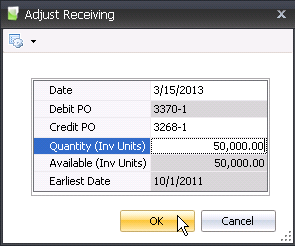
- Enter the Date
of the adjustment.
- The Debit PO
will auto-populate from the receiving transaction that is being adjusted.
- Select the Credit
PO to be adjusted.
- Enter the Quantity
(Inv Units) amount to be adjusted. This amount cannot
exceed the quantity received on the original receiving transaction,
nor can it exceed the inventory units of the Credit PO.
- Available (Inv
Units) is derived based on the following:
- If the Credit PO has a quantity inventory
that meets or exceeds the receiving transaction quantity, the
receiving quantity will be available.
- If the Credit PO has a quantity inventory
that is less than the receiving transaction quantity, the Credit
PO inventory + the purchase tolerance allowance will be available
for adjustment. For example, if the Credit PO inventory is 25,000
units and the ingredient version purchase tolerance is set to
5%, the Available units will be 26,250.
- Earliest Date
is the earliest date the adjustment can be made. This is derived from
the earliest receive date defined on the Credit PO.
- Click OK to adjust the purchase order quantities
for the amount defined on the dialogue. Not that the purchase order
on the receiving transaction does not get changed. It only moves the
quantity from one purchase order to another. The process will increase
the inventory for the Debit PO and decrease the available inventory
for the Credit PO.
- Adjustments can be viewed by right-clicking on
the receiving transaction and selection View
PO Adjustments or go to General>Purchases>Order
Adjustments to view the debit and credit adjustments.
View PO Adjustments
The View PO Adjustments allows the user to view any purchase order adjustments
that have been made to the receiving transaction.
- In the Ingredients Receiving index, select the
required receiving transaction and right-click to select View PO Adjustments
- The Ingredient Trans PO Adjustments will be displayed
with any adjustments that have been made to the purchase order on
the receiving transaction.

Replace
Purchase Order
If the purchase order has been received to the wrong PO, Replace Purchase
Order can be utilized to update quantities and amounts. From 'Replace
Purchase Order', a list of purchase orders for the same product can
be found in order to switch the PO. Replace Purchase Order will replace
the cost of the ingredients, where Create
PO Adjustment will only adjust the quantity of the ingredients.
Replace Purchase order cannot be used with a 'Posted' record.
- In the FMIM Ingredients Receiving index, highlight
the Active or Reversed record that needs to be replaced.
- Right-click and select Replace
Purchase Order.
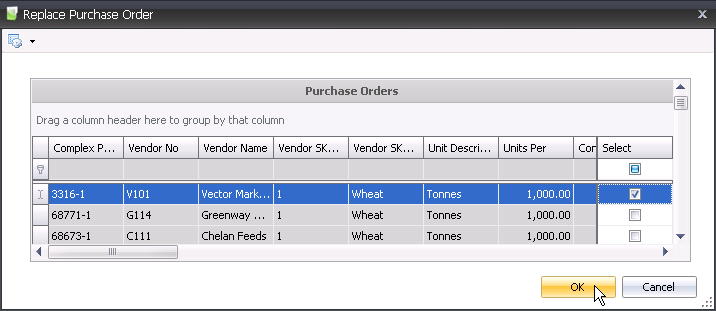
- Select the PO that will replace the original PO
by checking the flag in the Select
column.
Click 'OK'.
The original PO will be placed back in PO inventory
to be used at a later date.
If Delayed Freight was used to create the PO,
the Haulage Selection will need to be entered.
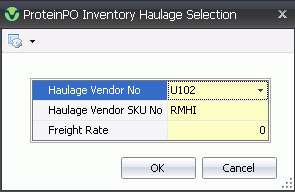
Select/Change the Haulage
Vendor No, if applicable.
Select/Change Haulage
Vendor Sku No, if applicable.
Enter the Freight
Rate.
The original PO will be placed back in PO inventory
to be used at a later date.
![]()
 to create a new record.
to create a new record.
 to create a new PO Inventory screen.
to create a new PO Inventory screen.





 in the top menu bar and select 'Post'.
in the top menu bar and select 'Post'.






